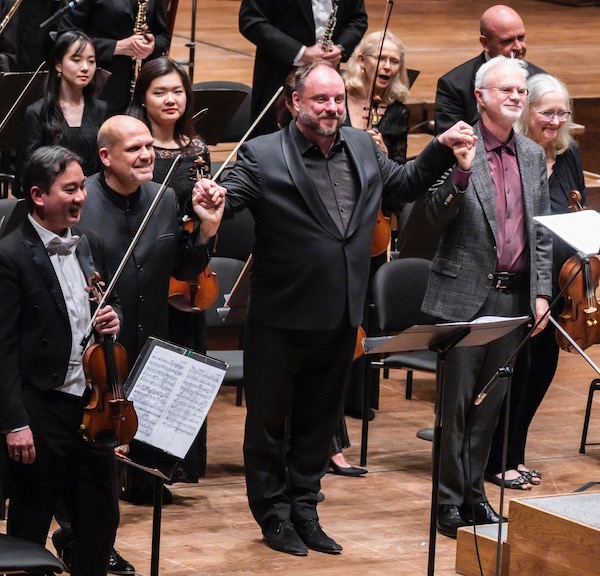Philharmonic explores a fresh, illuminating line from Brahms to Ives and Adams

Jaap van Zweden, Matthias Goerne and John Adams take a bow following the New York Philharmonic performance of Adams’ “The Wound Dresser” Thursday night. Photo: Chris Lee
Thursday night’s New York Philharmonic concert at David Geffen Hall seemed at first relatively modest, a kind of good-music-played-well evening. But nearly hidden in plain sight were some fascinating ideas about the orchestra, and America’s place in classical music.
With Jaap van Zweden conducting, the Philharmonic played music of Charles Ives, John Adams and Brahms. With Brahms’ Symphony No. 1 at the end, the concert provided an offbeat take on the traditional overture/concerto/symphony program—opening with Ives’ Central Park in the Dark, then Matthias Goerne singing Adams’ The Wound-Dresser before the Brahms First.
Central Park in the Dark is part of the Philharmonic’s institutional history. Beyond it being about life in New York City—Ives was living at 65 Central Park West one he wrote it—the work is indelibly associated with the orchestra and Leonard Bernstein, via two classic recordings. There’s a mise-en-abyme of complexity—the Philharmonic began with a mission to emulate European culture in America’s leading city during a time when the country was too young to feel confident in the quality of its own culture; and it was Ives who shrugged off European aesthetics and traditions to forge a new American art music.
Yet Central Park in the Dark is not nationalistic; it’s impressionistic, a sonic recreation of strolling along the park at night, hearing music drifting from homes and saloons, witnessing a carriage eaccident, all wrapped in Ives’ mystic chords of memory.
The Philharmonic sounded superb in this piece under van Zweden’s direction. The interpretation was more contemplative than raucous, and Ives’ drifting, distant chords were delicate and strong, incandescent but also cool and steely, like transparent silk pulled taught.
From Ives’ memories came Walt Whitman’s, via Adams. Whitman’s poem, “The Wound-Dresser,” comes out of his experience as a nurse, tending to wounded Civil War soldiers, young men for whom he felt tremendous tenderness and compassion, and even longing, facing their maimed bodies without qualms.
Firmer in form and harmonies, it also has some of the dream-like drift heard in Ives. The dark, round weight of Goerne’s voice quietly pushed each edge of emotion to an extreme point, so that the major key transformation late in the piece had tremendous power. The solo playing from concertmaster Frank Huang and principal trumpet Christopher Martin was exquisite—each had a beautiful tone and brought out deep expression in the music.
Brahms’ symphony is famous for being one of the most difficult works the composer produced, in that the creative process was long and arduous. Though the quality is close to that of his friend Schumann, Brahms had to work for more than a decade to pull away from the intimidating influence of Beethoven.
Brahms didn’t favor the results. The constant quality of his music is a warm, plangent, bittersweet sympathy, but the First Symphony is also full of clotted feelings, not least the stabbing timpani tattoos in the beginning. Despite the anxiety of influence which is plain in Brahms’ variation on Beethoven’s “Ode to Joy” in the final movement, there is still plenty of his own personality to tease out.
And that van Zweden and the Philharmonic did. In the fraught outer movements, the conductor did a subtle and effective thing with an understated pace and phrasing, keeping a strong and flowing pulse while having the strings play a fraction behind the beat, just enough to turn possible anxiety into a feeling of concentrated determination. That and the big, gorgeous sound that he has been cultivating in the orchestra—black grosgrain strings, pearly flutes, and sun-bronzed brass—made this a considerably lovely experience.
The interior movements are a respite from the outsized feelings of the opening and the conclusion. With van Zweden keeping the roughest qualities at a distance, these sounded more integrated into the full form than usual. The performance teased out the Schumann-esque quality of a long, lyrical line that connected through each movement. That may not always be there in most performances of this work but one clearly heard it Thursday.
The Philharmonic was one of the first American orchestras to play the symphony, and with that the concert closed a circle and opened up another. Ives came out from under the influence of Brahms to become an American composer, a New Yorker, and an important part of the Philharmonic’s history—Adams stands out Ives’ shoulders and sees back to the romantic era, in a program that nicely marked 100 years of incredible music.
This program repeats at 8 p.m. Saturday and 7:30 p.m. Tuesday, March 26. nyphil.org
Posted Mar 30, 2019 at 1:51 pm by betty Korson
I was terribly moved by the John Adams piece, and entranced by the Ives Central Park music. The Brahms took my breath away. I think the conductor is a dynamic,force and I look forward to hearing many m ore of his choices to perform with the orchestra.